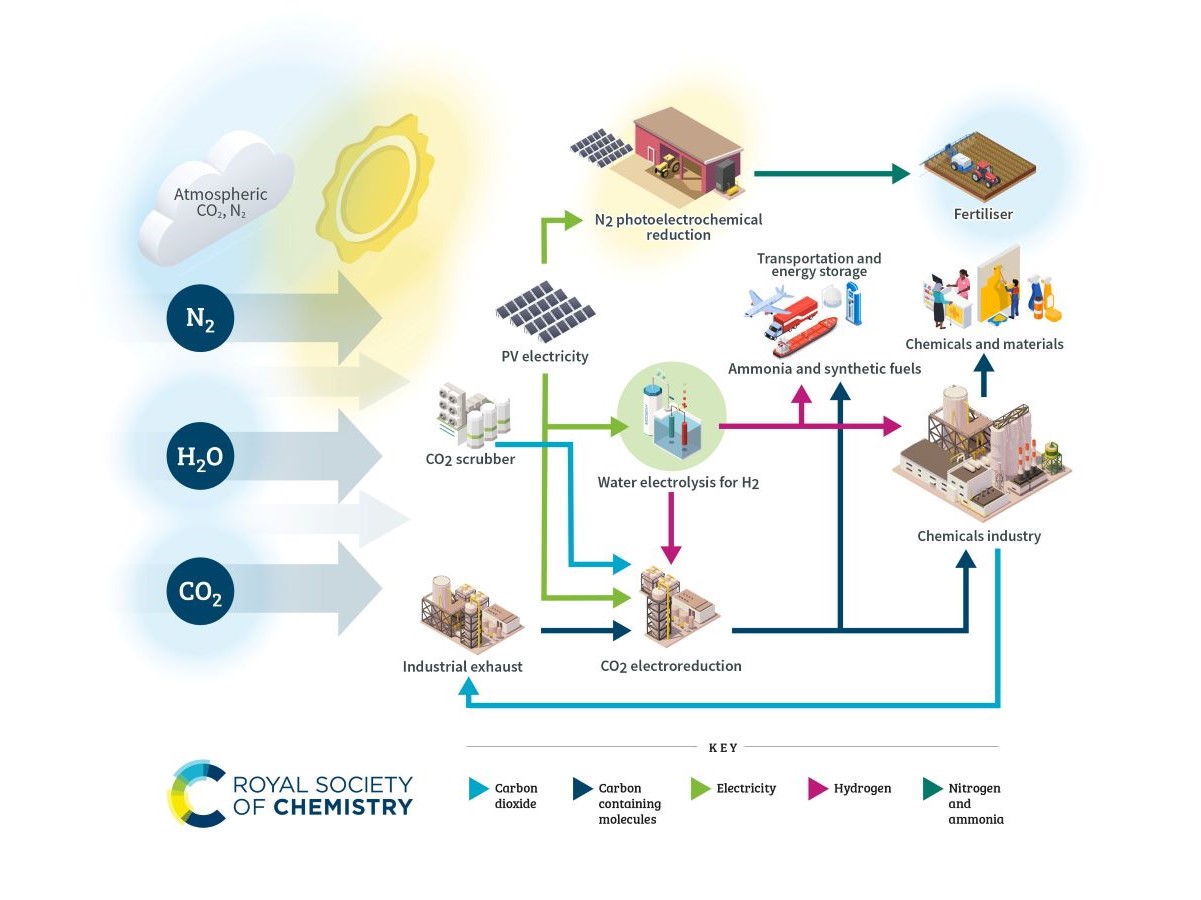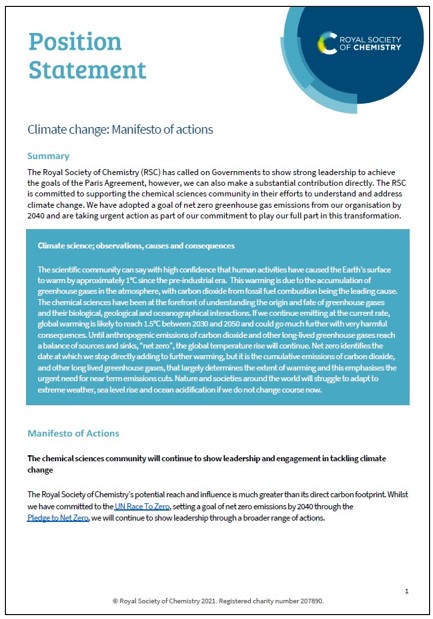The United Nations Framework Convention on Climate Change: The Conference of Parties (COP)
For nearly three decades the United Nations have been bringing together almost every country on earth for global climate summits, with the first conference held in Berlin in 1995. At these annual meetings, governments discuss how to mitigate and prepare for climate change.
We look forward to the next conference, COP29, coming up in November 2024. We have been gathering perspectives from around the chemical science community illustrating how chemistry is vital to understanding and tackling climate change.
Our position on climate change
Our position statement on climate change sets out our asks of government and how the chemical science community can contribute to tackling climate change.
Our Climate change: Manifesto of actions describes the actions we will take as an organisation to support the global transition to net zero.
Solar chemicals
Solar photovoltaic panels are delivering low-cost power around the world and form a major part of global efforts to tackle climate change. Less well known are the reactions and devices that could support a similar transformation of industrial chemical systems and fertiliser production. Nature does this all the time as through photosynthesis and subsequent reactions which create complex molecules to store energy and grow leaves, trunks and roots.

A range of different approaches are being investigated to harness this potential. Water, nitrogen and carbon dioxide from the environment can be combined in different ways using electrical energy from solar PV cells. Other pathways use photocatalytic materials that absorb light to facilitate reactions. These photocatalysts can be inorganic, transition metal compounds or biological molecules like enzyme complexes and chlorophyll centres. Biohybrid devices go further and incorporate parts of living organisms or whole genetically modified organisms in artificial surroundings to direct reactions towards desirable chemical compounds.
Solar chemical systems can already produce hydrogen and simple carbon containing molecules in the laboratory. However, they could ultimately be used to make many different consumer products such as plastics and paints, or fuels for aircraft and ships. Processes might take different forms; at an industrial scale, for instance using the waste carbon dioxide from chemical plants or power stations, or combined in small scale reactors, such as devices to produce fertiliser directly on farms.
To find out more about solar chemicals, their development and future applications and watch our webinar with leading experts in the field.
The impact of inadequate car battery recycling
Read our new consumer research on scepticism over UK Government's ability to create EV (electric vehicle) charging infrastructure, concerns over a lack of recycling options for electric vehicle batteries and a shortage of the natural resources used to produce them.
Find out more about our survey of UK drivers
Understanding and tackling climate change - previous events
In recent years, we have convened a series of events on chemical science’s role in tackling sustainability and climate change challenges, exploring opportunities and inspirational stories from across our global chemical science community, including many speakers from the , the UK's flagship battery research programme.
Watch the recordings now:
Beyond lithium ion batteries
This panel discussed the cutting edge chemistry underlying next generation battery innovations, their potential, their limitations and their pathways to mass adoption.
The circular economy of batteries
This panel discussed the latest research to develop pathways for the recycling and recovery of critical raw materials in batteries, to reach a circular economy.
The chemistry of hydrogen production and use
This panel discussed the latest chemistry which may open up a new hydrogen economy as we replace fossil fuels in power, transport and industry.
Biohybrid approaches for sustainable energy conversion
An engaging and accessible panel discussion, summarising the amazing science showcased at the recent Chemical ����ֱ��app���� Symposium featuring leading experts in the field, with a Q&A session.
Batteries for the United Nations Sustainable Development Goals
This panel discussed the opportunities and limitations of batteries in the context of global development and where science and innovation can improve them towards achieving the United Nations SDGs.
Solar Fuels and Chemicals - with the UK Solar Fuels Network
Solar fuels and chemicals store energy from sunlight in chemical bonds using abundant resources such as water and carbon dioxide. The products can be used directly as fuels or the building blocks of other useful chemicals.
Air quality and climate protection in the global south
The air quality problem and the chemistry behind it. Innovations in remote sensing and the use of drones, the chemistry of combustion, and the technologies that can be deployed.
Carbon dioxide utilisation/CCUS - Faraday Discussion
This panel event summarised progress on using waste CO2 to make some of the most important materials for modern society; polymers and plastics, chemical intermediates, fuels and cement.
MOFs for energy and environment – Faraday Discussion
Metal Organic Frameworks (MOFs) are a hot topic because they have so many potential uses including hydrogen storage, water capture, carbon capture and cleaning up air pollution.
Materials Chemistry enabling sustainability
This panel discussed how materials chemistry underpins many technologies and industries and how advances can increase sustainability.
Plastics and
climate change
This panel discussed the intersecting issues of plastic and climate change, alternative raw materials, and the impact of dealing with plastic waste.
Climate impacts of agriculture
This panel summarised our understanding of CO2 and methane, their agricultural sources, what can be done and where further research is focussed.
The chemistry of Nature Based Solutions
Discussing the potential for
Nature Based Solutions (NBS)
to tackle climate change
and the carbon flows
and storage in different
ecosystems.
Wildfires – influence on air, soil, and water
This panel discussed how wildfires affect soil, air, and water.
Watch the video to see how the chemical sciences can deliver a big impact in addressing this global challenge.
The Net Zero
Laboratory
Experts from academia and industry discuss the steps organisations and individuals working in science can take to reduce emissions and identify the challenges that remain.
Other events
Please see our events webpages for a full programme of sustainability events and environmental activities.
Education and careers
Please see our Education in Chemistry website to view a series of for secondary teachers and students.
Our website illustrates the breadth of opportunities for chemists and students who want a career tackling climate change. Find out more about developing coatings for wind turbines, new ways of recycling batteries, making leather substitutes from pineapple waste and lots more.
#PoweredByChemistry
Across the COP series, we have been focusing on chemistry’s unique opportunity to bridge the gap between the SDGs; in particular and .
Scarce elements power the technology that we can use to create a net zero future. We need to source, use and reuse these elements in a sustainable way.
Chemistry is at the heart of a new way of capturing, storing and converting energy for a net zero future.
Our SME showcase
Our small and medium enterprise community (SME) is offering innovative solutions to the big sustainability challenges of the day.
The videos below show SMEs representing different solutions ranging from solar energy to fast charging battery technologies.
Carbon capture
Carbon capture and utilisation offers a solution to turning the abundance of waste CO2 from industry into something useful. Chemistry SME ViridiCO2 tells us about their new catalytic technology, which transforms CO2 into polymers for use in everyday products, while at the same time using CO2 instead of fossil fuels to carry out their processes. Watch their story:
Fast charging batteries
have developed a safe, fast charging battery technology based on sustainable materials which can be charged much faster than current batteries and for many more cycles. This will accelerate the electrification of trains, buses and other vehicles, helping overcome the challenge in the race to zero emissions transport. Watch their story:
Solar power
Solar power is a clean and sustainable power source, but innovation is needed to make it more efficient, useful and cost less. have developed a tandem solar cell, using perovskite and silicon, that has resulted in record breaking efficiency. Watch their video to find out how:
Green hydrogen
Green hydrogen is CO2 free at the point of generation. It has applications in heating homes, industrial fuels, and powering transport options from cars to planes. In this SME showcase, tell us about how their products will contribute to net zero goals.
Related pages
- Our two-year strategic approach to sustainability 2021-2022
- Laboratories are working to reduce the carbon footprint of their research
- Our policy on the circular economy of precious metals
- How can we make paint more sustainable?
- Chemistry can help the composites sector move towards more sustainable practices
- A task force of industry leaders are working with us to make polymers in liquid formulations more sustainable
- Listen to our award winning podcasts covering many aspects of sustainability
- Our other environmental and sustainability work
- See all our policies, reports, evidence and campaigns



